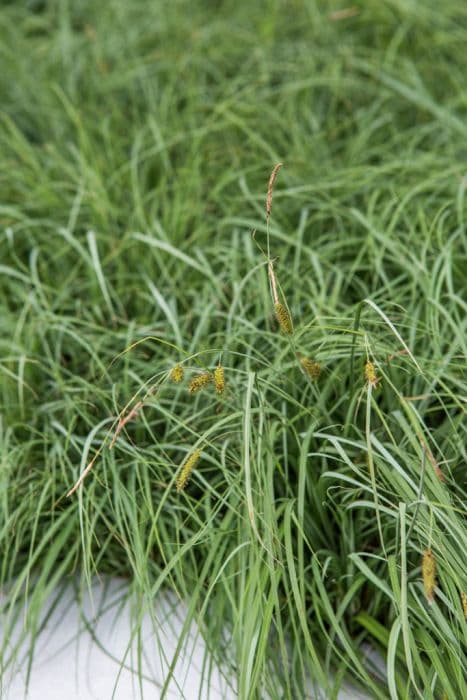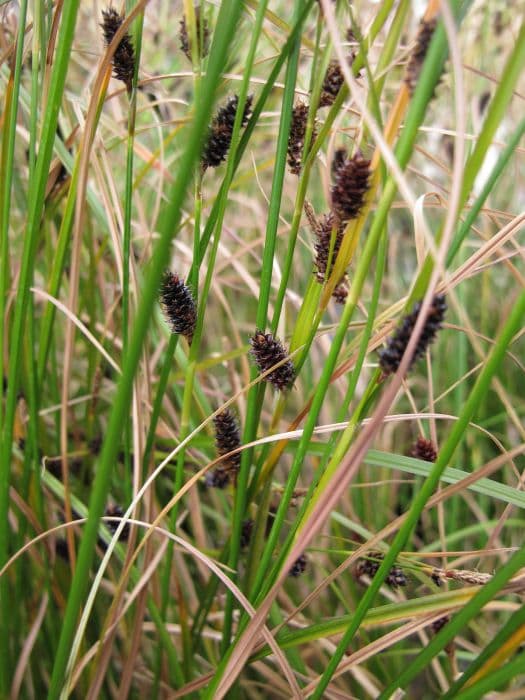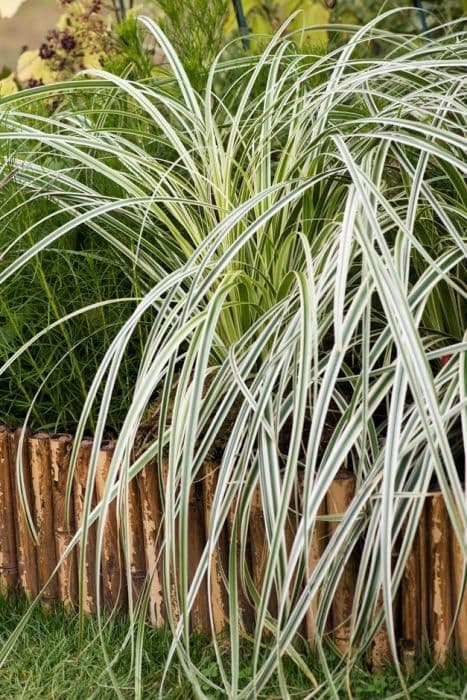Everest Sedge Carex oshimensis Everest = 'Fiwhite' (PBR) (v)
![Japanese sedge [Everest]](/_next/image?url=https%3A%2F%2Fplants-admin.emdemapps.com%2Fimages%2Fplants%2F%2Fimages%2F604b5b6de0548.png&w=3840&q=75)
ABOUT
Carex oshimensis Everest, also known as Everest Sedge, boasts a strikingly ornamental appearance. This plant is admired for its variegated foliage, featuring leaves edged with pure white margins that contrast beautifully against the bright green centers. The leaves are narrow and arching, creating a fountain-like effect that adds texture and movement to gardens or container plantings. This foliage variegation remains vibrant throughout the growing season, lending a consistent splash of color to the landscape. Everest Sedge has a clumping habit, with the tufts of foliage growing together in a tidy and dense manner, giving the plant a lush, full-bodied look. The overall effect of this plant is one of elegance and visual interest, making it a popular choice for a wide range of garden designs and settings.
About this plant
 Names
NamesFamily
Cyperaceae
Synonyms
Everest Sedge, Variegated Japanese Sedge, Everest Japanese Sedge
Common names
Carex oshimensis 'Everest'
 Toxicity
ToxicityTo humans
The Carex oshimensis 'Everest', commonly known as Japanese Sedge 'Everest', is not known to be toxic to humans. It is a popular ornamental grass and there are no widespread reports of poisoning from ingesting any part of this plant. However, it is generally advisable not to consume any plant material that is not known to be edible, as it could cause discomfort or an allergic reaction in some individuals.
To pets
The Carex oshimensis 'Everest', commonly known as Japanese Sedge 'Everest', is also not known to be toxic to pets. This ornamental grass is considered safe around pets, and there have been no significant reports of poisoning in animals from ingesting this plant. It is always best to prevent pets from eating ornamental plants as a precaution, but Japanese Sedge 'Everest' is typically not a cause for concern.
 Characteristics
CharacteristicsLife cycle
Perennials
Foliage type
Evergreen
Color of leaves
Variegated
Height
1 foot 8 inches (50 cm)
Spread
1 foot 8 inches (50 cm)
Plant type
Herb
Hardiness zones
5
Native area
Japan
Benefits
 General Benefits
General Benefits- Low Maintenance: This plant is relatively easy to care for and does not require frequent watering or complex care routines.
- Drought-Tolerant: Once established, Everest Sedge has good resistance to periods of drought, reducing the need for regular irrigation.
- Compact Growth: With its clumping habit, it is suitable for small gardens and spaces without becoming invasive.
- Cold Hardy: This plant can withstand cold temperatures, making it suitable for a variety of climates and useful in perennial borders.
- Ornamental Appeal: The white-edged foliage provides visual interest and contrast in the garden throughout the growing season.
- Erosion Control: The dense root system can help stabilize soil and prevent erosion on slopes or in areas prone to soil degradation.
- Versatile Use: Suitable for use in containers, borders, and as ground cover, providing flexibility in garden design and landscaping.
- Attracts Wildlife: The plant can attract birds and beneficial insects to the garden, fostering a healthy ecosystem.
- Deer Resistant: Less appealing to deer, which makes it a good choice for gardens in areas with high deer populations.
 Medical Properties
Medical PropertiesThis plant is not used for medical purposes.
 Air-purifying Qualities
Air-purifying QualitiesThis plant is not specifically known for air purifying qualities.
 Other Uses
Other Uses- As a visual barrier in landscape design: The dense foliage of Carex Everest can be used to create a natural privacy screen or to obscure unsightly views in a garden landscape.
- For erosion control on slopes: Its strong root system helps to stabilize soil and prevent erosion on sloped areas in the garden.
- In water features: Carex Everest can be planted around ponds or streams to add greenery and contrast to the water's edge, as it tolerates moist conditions well.
- As a tactile element in sensory gardens: The fine, soft texture of its leaves can provide a unique tactile experience for visitors of sensory gardens.
- For winter interest: Carex Everest has evergreen foliage, meaning it can add color and structure to a winter garden when other plants have died back.
- As a container plant: This sedge can thrive in containers, providing year-round foliage for patios, balconies, and other outdoor spaces.
- In floral arrangements: The arching foliage and flower spikes of Carex Everest can be used to add texture and greenery to cut flower arrangements.
- As a habitat for wildlife: It can offer shelter and nesting material for small garden creatures and beneficial insects.
- To accentuate garden pathways: Planting this sedge along walkways can add a soft, flowing edge, enhancing the aesthetic of garden paths.
- As a groundcover under deciduous trees: Carex Everest can grow in the dappled shade under trees, providing a lush carpet of green that competes with unwanted weeds.
Interesting Facts
 Feng Shui
Feng ShuiThe Carex Everest is not used in Feng Shui practice.
 Zodiac Sign Compitability
Zodiac Sign CompitabilityThe Carex Everest is not used in astrology practice.
 Plant Symbolism
Plant Symbolism- Adaptability: The Carex oshimensis Everest, commonly known as 'Everest Sedge,' thrives in a variety of conditions, signifying the ability to adapt and prosper in diverse environments.
- Resilience: As a hardy perennial, Everest Sedge represents the ability to withstand challenging conditions and bounce back from adversity.
- Balance: The plant's foliage, which often forms a neat, mounded habit, can symbolize balance and order within one's life or environment.
- Peace: The cool green and white variegated leaves can evoke a sense of tranquility and peace, much like a serene, natural landscape.
 Water
WaterThe Everest Sedge prefers consistent moisture, so it's best to water it once or twice a week, depending on weather conditions. Use a gentle water flow to avoid unsettling the plant or eroding the soil around it. During the hottest parts of the summer, water enough to ensure the equivalent of 1 inch of rainfall per week. In cooler temperatures or during periods of rainfall, reduce watering accordingly. Overwatering can be just as harmful as under-watering, so ensure the soil has good drainage and doesn't stay soggy.
 Light
LightEverest Sedge thrives in partial to full shade, making it an excellent choice for a spot that receives filtered sunlight throughout the day. Avoid placing it in direct, harsh sunlight as it can scorch the foliage. The ideal location would mimic its natural habitat, providing some shelter from hot afternoon sun while still offering bright, indirect light.
 Temperature
TemperatureEverest Sedge is hardy and can withstand a range of temperatures, but it performs best in conditions between 50°F and 75°F. This plant can tolerate a minimum temperature down to around 20°F; however, it may need protection in extreme cold. It is not tolerant of high heat, especially if combined with direct sunlight, so keep it in cooler, shaded areas during the hottest parts of the year.
 Pruning
PruningPruning the Everest Sedge is primarily about maintaining its tidy appearance and removing any brown or damaged leaves. Trim the plant back in late winter or early spring before new growth starts, cutting the foliage down to about 3 inches from the ground. This task is usually done annually to encourage fresh, healthy growth and to keep the plant looking its best.
 Cleaning
CleaningAs needed
 Soil
SoilCarex 'Everest' thrives in a well-draining soil mix rich in organic matter with a pH range of 5.5 to 7.0. A blend of garden soil, compost, and a bit of sand or perlite to improve drainage constitutes the best soil mix for this sedge.
 Repotting
RepottingCarex 'Everest' does not require frequent repotting and can be repotted every 2-3 years or when it outgrows its current container. It's best to repot in the spring when the plant is actively growing.
 Humidity & Misting
Humidity & MistingCarex 'Everest' prefers moderate humidity levels but is quite adaptable and can tolerate the humidity levels typically found in most homes. It does not have specific high humidity requirements, unlike some other houseplants.
 Suitable locations
Suitable locationsIndoor
Place in bright, indirect light with occasional watering.
Outdoor
Plant in partial shade, moist well-draining soil.
Hardiness zone
5-9 USDA
 Life cycle
Life cycleCarex oshimensis 'Everest' begins its life as a seed, which upon germination develops into a small seedling. The seedling then grows into a clump-forming perennial grass with variegated foliage that is striking in shade gardens. As it matures, the plant produces dense tufts of narrow, arching, white-edged green leaves that maintain their attractive appearance throughout the growing season. During late spring to early summer, Carex 'Everest' may produce brown flower spikes, though these are rather inconspicuous compared to the decorative leaves. Once established, it enters a period of vegetative growth where it can spread by rhizomes to form a larger clump. Finally, in its mature stage, the plant can be divided and transplanted to propagate new plants, and it will continue to live and grow for several years with proper care, showing minimal senescence during the cool seasons.
 Propogation
PropogationPropogation time
Spring to summer
Carex oshimensis 'Everest', also widely known as variegated Japanese sedge or Everest sedge, is most commonly propagated through division. Propagation by division is ideally done in the spring when the plants begin actively growing. To propagate the Everest sedge, carefully dig up an established clump and gently separate it into smaller sections, ensuring that each section has a portion of the root system intact. These new sections can then be replanted at the same depth they were originally growing. Water the newly planted divisions well to help establish them. This method is straightforward and allows the gardener to increase their stock of plants while maintaining the unique characteristics of the 'Everest' variety.









